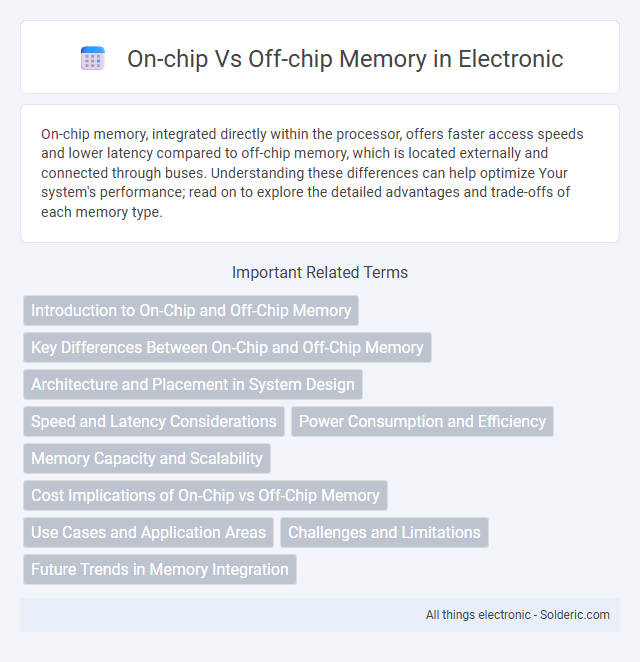On-chip memory, integrated directly within the processor, offers faster access speeds and lower latency compared to off-chip memory, which is located externally and connected through buses. Understanding these differences can help optimize Your system's performance; read on to explore the detailed advantages and trade-offs of each memory type.
Comparison Table
| Feature | On-chip Memory | Off-chip Memory |
|---|---|---|
| Location | Integrated within the CPU or SoC | Located outside the CPU or SoC |
| Access Speed | High-speed, low latency | Slower due to bus and interface delays |
| Size | Limited capacity (KB to MB) | Large capacity (MB to GB or more) |
| Power Consumption | Lower power, efficient for frequent access | Higher power, due to longer data paths |
| Cost | Higher cost per bit | Lower cost per bit |
| Complexity | Simpler integration and timing | Requires complex interface circuitry |
| Common Usage | Cache memory, registers, embedded SRAM | DRAM, external storage, expansion memory |
Introduction to On-Chip and Off-Chip Memory
On-chip memory refers to memory integrated directly within the processor chip, offering faster data access and reduced latency compared to off-chip memory, which is located externally on separate memory modules. Off-chip memory typically provides larger storage capacity but incurs slower access times due to communication across the system bus. Understanding the trade-offs between on-chip and off-chip memory can help optimize Your system's performance and efficiency in processing tasks.
Key Differences Between On-Chip and Off-Chip Memory
On-chip memory is integrated directly within the processor chip, offering faster access speeds and lower latency compared to off-chip memory, which is located externally on the motherboard or circuit board. While on-chip memory, such as cache or registers, provides limited capacity optimized for speed, off-chip memory like DRAM delivers larger storage but with slower data transfer rates due to physical separation and bus constraints. Power consumption and cost per bit also differ significantly, with on-chip memory being more expensive and power-efficient per unit but optimized for critical high-speed data retrieval tasks, whereas off-chip memory supports bulk storage at lower costs.
Architecture and Placement in System Design
On-chip memory is integrated directly within the processor die, providing low latency and high bandwidth access crucial for cache and register storage, while off-chip memory resides on separate modules connected via memory buses, offering larger capacities but higher latency. In system design, on-chip memory enables faster data retrieval essential for CPU performance optimization, whereas off-chip memory supports bulk data storage and system scalability. Balancing architecture and placement involves optimizing these trade-offs to enhance overall system throughput and power efficiency.
Speed and Latency Considerations
On-chip memory offers significantly lower latency and higher speed due to its close proximity to the CPU core, enabling faster data access and improved overall system performance. Off-chip memory, such as DRAM, exhibits higher latency caused by longer physical distances and slower data transfer rates, which can bottleneck processing speed in high-demand applications. Optimizing system design often involves balancing on-chip cache size with off-chip memory capacity to minimize latency while maximizing speed.
Power Consumption and Efficiency
On-chip memory, such as SRAM integrated within the processor, offers significantly lower power consumption and higher efficiency due to reduced data transfer distances and faster access times. Off-chip memory like DRAM, while providing larger capacity, consumes more power and increases latency because of longer signal paths and additional interface circuitry. Optimizing your system's power profile involves prioritizing on-chip memory for frequently accessed data to maximize energy efficiency and performance.
Memory Capacity and Scalability
On-chip memory typically offers lower capacity but faster access speeds due to its close integration with the processor, making it ideal for cache and small data buffers. Off-chip memory provides significantly larger capacity and better scalability, accommodating extensive data storage needs through technologies like DRAM and external flash. The trade-off between on-chip and off-chip memory centers on optimizing performance and capacity, with scalable off-chip memory supporting expanding workloads while on-chip memory enhances immediate data access efficiency.
Cost Implications of On-Chip vs Off-Chip Memory
On-chip memory offers faster access speeds and reduced latency but comes at a higher cost per bit due to limited silicon area and complex fabrication processes. Off-chip memory provides a cost-effective solution for larger storage needs, though it incurs additional expenses related to packaging, board space, and power consumption. Your choice between on-chip and off-chip memory directly impacts the overall system cost and performance balance.
Use Cases and Application Areas
On-chip memory, integrated within the processor, is ideal for applications requiring ultra-fast access and low latency, such as real-time data processing, embedded systems, and high-performance computing tasks. Off-chip memory, located outside the processor chip, suits applications needing large storage capacity like multimedia systems, data centers, and general-purpose computing where speed trade-offs are acceptable. Your choice between on-chip and off-chip memory depends on balancing speed requirements with storage size and cost constraints in your specific use case.
Challenges and Limitations
On-chip memory faces limitations in capacity and heat dissipation due to its physical proximity to the processor, restricting scalability and increasing manufacturing costs. Off-chip memory encounters latency and bandwidth bottlenecks caused by longer data paths and signal integrity issues, impacting overall system performance. Both memory types struggle with power consumption management, as increased speed and size exacerbate heat generation and energy efficiency challenges.
Future Trends in Memory Integration
Future trends in memory integration emphasize the increasing convergence of on-chip and off-chip memory technologies to enhance performance and energy efficiency in computing systems. Advances in 3D-stacked memory and heterogeneous integration enable tighter coupling of on-chip caches with off-chip DRAM, reducing latency and boosting bandwidth. Your applications will benefit from these innovations as memory hierarchies evolve to support higher data throughput and lower power consumption in next-generation processors.
On-chip vs Off-chip memory Infographic

 solderic.com
solderic.com